Artificial Neural Networks Applications and Algorithms
What are the parts of Neuron and their Functions?
The typical nerve cell of the human brain comprises of four parts:
Function of Dendrite
It receives signals from other neurons.
Soma (cell body)
It sums all the incoming signals to generate input.
Axon Structure
It sums all the incoming signals to generate input.
When the sum reaches a threshold value, the neuron fires, and the signal travels down the axon to the other neurons.
Synapses Working
The point of interconnection of one neuron with other neurons. The amount of signal transmitted depends upon the strength (synaptic weights) of the connections. 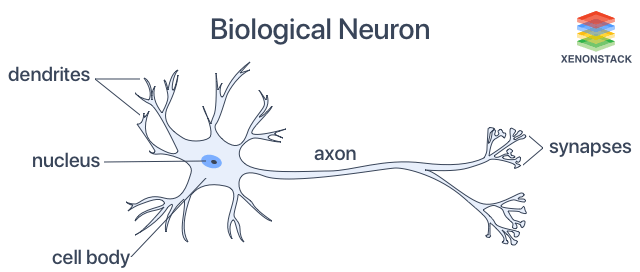 The connections can be inhibitory (decreasing strength) or excitatory (increasing strength) in nature. So, a neural network, in general, has a connected network of billions of neurons with a trillion of interconnections between them.
The connections can be inhibitory (decreasing strength) or excitatory (increasing strength) in nature. So, a neural network, in general, has a connected network of billions of neurons with a trillion of interconnections between them.
What is the difference between brain and computer?
What is the difference between Artificial Neural Networks (ANN) VS Biological Neural Networks (BNN)?
Characteristics
Artificial Neural Network (ANN)
Biological(Real) Neural Network (BNN)
Speed
Faster in processing information. Response time is in nanoseconds.
Slower in processing information. The response time is in milliseconds.
Processing
Serial processing.
Massively parallel processing.
Size & Complexity
Less size & complexity. It does not perform complex pattern recognition tasks.
A highly complex and dense network of interconnected neurons containing neurons of the order of 1011 with 1015 of interconnections.<strong
Storage
Information storage is replaceable means replacing new data with an old one.
A highly complex and dense network of interconnected neurons containing neurons of the order of 1011 with 1015 of interconnections.
Fault tolerance
Fault intolerant. Corrupt information cannot retrieve in case of failure of the system.
Information storage is adaptable means new information is added by adjusting the interconnection strengths without destroying old information.
Control Mechanism
There is a control unit for controlling computing activities
No specific control mechanism external to the computing task
Artificial Neural Networks with Biological Neural Network
Neural Networks resemble the human brain in the following two ways –
- A neural network acquires knowledge through learning.
- A neural network’s knowledge is a store within inter-neuron connection strengths known as synaptic weights.
Von Neumann Architecture Based Computing
Ann Based Computing
Serial processing – processing instruction and problem rule one at the time (sequential)
Parallel processing – several processors perform simultaneously (multitasking)
Function logically with a set of if & else rules – rule-based approach
Function by learning pattern from a given input (image, text or video, etc.)
Programmable by higher-level languages such as C, Java, C++, etc.
ANN is, in essence, the program itself.
Requires either big or error-prone parallel processors
Use of application-specific multi-chips.
Artificial Neural Network (ANN) Vs Biological Neural Network (BNN)
- The Biological Neural Network’s dendrites are analogous to the weighted inputs based on their synaptic interconnection in it.
- The cell body is comparable to the artificial neuron unit in it, comprising summation and threshold unit.
- Axon carries output that is analogous to the output unit in the case of it. So, it is model using the working of basic biological neurons.
How does it works?
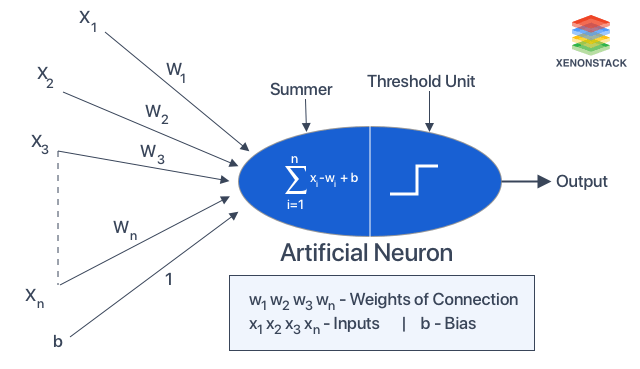
- It can be viewed as weighted directed graphs in which artificial neurons are nodes, and directed edges with weights are connections between neuron outputs and neuron inputs.
- The Artificial Neural Network receives information from the external world in pattern and image in vector form. These inputs are designated by the notation x(n) for n number of inputs.
- Each input is multiplied by its corresponding weights. Weights are the information used by the neural network to solve a problem. Typically weight represents the strength of the interconnection between neurons inside the Neural Network.
- The weighted inputs are all summed up inside the computing unit (artificial neuron). In case the weighted sum is zero, bias is added to make the output not- zero or to scale up the system response. Bias has the weight and input always equal to ‘1′.
- The sum corresponds to any numerical value ranging from 0 to infinity. To limit the response to arrive at the desired value, the threshold value is set up. For this, the sum is forward through an activation function.
- The activation function is set to the transfer function to get the desired output. There are linear as well as the nonlinear activation function.
What are the commonly used activation functions?
Some of the commonly used activation function is – binary, sigmoidal (linear) and tan hyperbolic sigmoidal functions(nonlinear).
- Binary – The output has only two values, either 0 and 1. For this, the threshold value is set up. If the net weighted input is greater than 1, the output is assumed as one otherwise zero.
- Sigmoidal Hyperbolic – This function has an ‘S’ shaped curve. Here the tan hyperbolic function is used to approximate output from net input. The function is defined as – f (x) = (1/1+ exp(-????x)) where ???? – steepness parameter.
What are its various types ?
Parameter
Types
Description
Based on the connection pattern
FeedForward, Recurrent
Feedforward – In which graphs have no loops. Recurrent – Loops occur because of feedback.
Based on the number of hidden layers
Single-layer, Multi-Layer
Single Layer – Having one secret layer. E.g., Single Perceptron Multilayer – Having multiple secret layers. Multilayer Perceptron
Based on the nature of weights
Fixed, Adaptive
Fixed – Weights are a fixed priority and not changed at all. Adaptive – Updates the weights and changes during training.
Based on the Memory unit
Static, Dynamic
Static – Memoryless unit. The current output depends on the current input. E.g., Feedforward network. Dynamic – Memory unit – The output depends upon the current input as well as the current output. E.g., Recurrent Neural Network
Neural Network Architecture Types
-
Perceptron Model in Neural Networks
-
Radial Basis Function Neural Network
-
Multilayer Perceptron Neural Network
-
Recurrent Neural Network
-
Long Short-Term Memory Neural Network (LSTM)
-
Hopfield Network
-
Boltzmann Machine Neural Network
-
Convolutional Neural Network
-
Modular Neural Network
-
Physical Neural Network
-
Perceptron Model
Neural Network is having two input units and one output unit with no hidden layers. These are also known as ‘single-layer perceptrons.’
-
Radial Basis Function
These networks are similar to the feed-forward Neural Network, except radial basis function is used as these neurons’ activation function.
-
Multilayer Perceptron
These networks use more than one hidden layer of neurons, unlike single-layer perceptron. These are also known as Deep Feedforward Neural Networks.
-
Recurrent
Type of Neural Network in which hidden layer neurons have self-connections. It possess memory. At any instance, the hidden layer neuron receives activation from the lower layer and its previous activation value.
-
Long Short-Term Memory Neural Network (LSTM)
The type of Neural Network in which memory cell is incorporated into hidden layer neurons is called LSTM network.
-
Hopfield Network
A fully interconnected network of neurons in which each neuron is connected to every other neuron. The network is trained with input patterns by setting a value of neurons to the desired pattern. Then its weights are computed. The weights are not changed. Once trained for one or more patterns, the network will converge to the learned patterns. It is different from other Neural Networks.
-
Boltzmann Machine Neural Network
These networks are similar to the Hopfield network, except some neurons are input, while others are hidden in nature. The weights are initialized randomly and learn through the backpropagation algorithm.
-
Convolutional Neural Network
Get a complete overview of it through our blog Log Analytics with Machine Learning and Deep Learning.
-
Modular Neural Network
It is the combined structure of different types of it like multilayer perceptron, Hopfield Network, Recurrent Neural Network, etc., which are incorporated as a single module into the network to perform independent subtask of whole complete.
-
Physical Neural Network
In this type of Artificial Neural Network, electrically adjustable resistance material is used to emulate synapse instead of software simulations performed in the neural network.
Artificial Intelligence collects and analyze data using smart sensors or machine learning algorithms and automatically route service requests to reduce the human workload.
Click to explore about our, Artificial Intelligence Applications
Hardware Architecture for Neural Networks
Two types of methods are used for implementing hardware for it.
- Software simulation in conventional computer
- A special hardware solution for decreasing execution time.
When Neural Networks are used with fewer processing units and weights, software simulation is performed on the computer directly. E.g., voice recognition, etc. When Neural Network Algorithms developed to the point where useful things can be done with 1000’s neurons and 10000’s of synapses, high-performance Neural network hardware will become essential for practical operation. E.g., GPU (
Learning Techniques
The neural network learns by adjusting its weights and bias (threshold) iteratively to yield the desired output. These are also called free parameters. For learning to take place, the Neural Network is trained first. The training is performed using a defined set of rules, also known as the learning algorithm.
Training Algorithms
-
Gradient Descent Algorithm
This is the simplest training algorithm used in the case of a supervised training model. In case the actual output is different from the target output, the difference or error is find out. The gradient descent algorithm changes the weights of the network in such a manner to minimize this mistake.
-
Back Propagation Algorithm
It is an extension of the gradient-based delta learning rule. Here, after finding an error (the difference between desired and target), the error is propagated backward from the output layer to the input layer via the hidden layer. It is used in the case of Multi-layer Neural Network.
Learning Data Sets
-
Training Data Set
A set of examples used for learning is to fit the parameters [i.e., weights] of the network. One approach comprises one full training cycle on the training set.
-
Validation Set Approach
A set of examples used to tune the parameters [i.e., architecture] of the network. For example, to choose the number of hidden units in a Neural Network.
-
Making Test Set
A set of examples is used only to assess the performance [generalization] of a fully specified network or apply successfully to predict output whose input is known.
What are the Five Algorithms to Train a Neural Network?
- Hebbian Learning Rule
- Self – Organizing Kohonen Rule
- Hopfield Network Law
- LMS algorithm (Least Mean Square)
- Competitive Learning
What is the architecture of it?
A typical Neural Network contains a large number of artificial neurons called units arranged in a series of layers. In typical Artificial Neural Network comprises different layers – 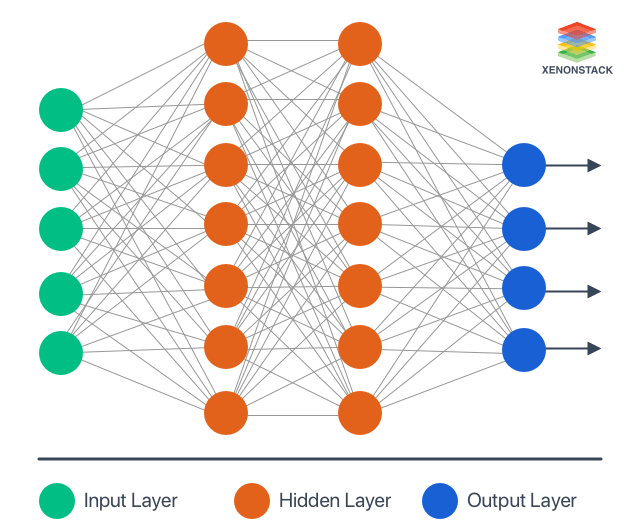
- Input layer – It contains those units (Artificial Neurons) which receive input from the outside world on which the network will learn, recognize about, or otherwise process.
- Output layer – It contains units that respond to the information about how it learn any task.
- Hidden layer – These units are in between input and output layers. The hidden layer’s job is to transform the input into something that the output unit can use somehow.
Connect Neural Networks, which means say each hidden neuron links completely to every neuron in its previous layer(input) and the next layer (output) layer.
What are the Learning Techniques in Neural Networks?
Neural Networks resemble the human brain in the following two ways -Some of the commonly used activation function is – binary, sigmoidal (linear) and tan hyperbolic sigmoidal functions(nonlinear).Neural Network is having two input units and one output unit with no hidden layers. These are also known as ‘single-layer perceptrons.’These networks are similar to the feed-forward Neural Network, except radial basis function is used as these neurons’ activation function.These networks use more than one hidden layer of neurons, unlike single-layer perceptron. These are also known as Deep Feedforward Neural Networks.Type of Neural Network in which hidden layer neurons have self-connections. It possess memory. At any instance, the hidden layer neuron receives activation from the lower layer and its previous activation value.The type of Neural Network in which memory cell is incorporated into hidden layer neurons is called LSTM network.A fully interconnected network of neurons in which each neuron is connected to every other neuron. The network is trained with input patterns by setting a value of neurons to the desired pattern. Then its weights are computed. The weights are not changed. Once trained for one or more patterns, the network will converge to the learned patterns. It is different from other Neural Networks.These networks are similar to the Hopfield network, except some neurons are input, while others are hidden in nature. The weights are initialized randomly and learn through the backpropagation algorithm.Get a complete overview of it through our blog Log Analytics with Machine Learning and Deep Learning.It is the combined structure of different types of it like multilayer perceptron, Hopfield Network, Recurrent Neural Network, etc., which are incorporated as a single module into the network to perform independent subtask of whole complete.In this type of Artificial Neural Network, electrically adjustable resistance material is used to emulate synapse instead of software simulations performed in the neural network.Two types of methods are used for implementing hardware for it.When Neural Networks are used with fewer processing units and weights, software simulation is performed on the computer directly. E.g., voice recognition, etc. When Neural Network Algorithms developed to the point where useful things can be done with 1000’s neurons and 10000’s of synapses, high-performance Neural network hardware will become essential for practical operation. E.g., GPU ( Graphical processing unit ) in the case of Deep Learning algorithms in object recognition, image classification, etc. The implementation’s performance is measured by connection per the second number (cps), i.e., the number of the data chunk is transported through the neural network’s edges. While the performance of the learning algorithm is measured in the connection updates per second (cups)The neural network learns by adjusting its weights and bias (threshold) iteratively to yield the desired output. These are also called free parameters. For learning to take place, the Neural Network is trained first. The training is performed using a defined set of rules, also known as the learning algorithm.This is the simplest training algorithm used in the case of a supervised training model. In case the actual output is different from the target output, the difference or error is find out. The gradient descent algorithm changes the weights of the network in such a manner to minimize this mistake.It is an extension of the gradient-based delta learning rule. Here, after finding an error (the difference between desired and target), the error is propagated backward from the output layer to the input layer via the hidden layer. It is used in the case of Multi-layer Neural Network.A set of examples used for learning is to fit the parameters [i.e., weights] of the network. One approach comprises one full training cycle on the training set.A set of examples used to tune the parameters [i.e., architecture] of the network. For example, to choose the number of hidden units in a Neural Network.A set of examples is used only to assess the performance [generalization] of a fully specified network or apply successfully to predict output whose input is known.A typical Neural Network contains a large number of artificial neurons called units arranged in a series of layers. In typical Artificial Neural Network comprises different layers -Connect Neural Networks, which means say each hidden neuron links completely to every neuron in its previous layer(input) and the next layer (output) layer.
Here is a list of Learning Techniques
- Supervised Learning
- Unsupervised Learning
- Reinforcement Learning
- Offline Learning
- Online Learning
We Discuss each one of them in length
- Supervised Learning
In this learning, the training data is input to the network, and the desired output is known weights are adjusted until production yields desired value.
- Unsupervised Learning
Use the input data to train the network whose output is known. The network classifies the input data and adjusts the weight by feature extraction in input data.
- Reinforcement Learning
We Discuss each one of them in lengthIn this learning, the training data is input to the network, and the desired output is known weights are adjusted until production yields desired value.Use the input data to train the network whose output is known. The network classifies the input data and adjusts the weight by feature extraction in input data.
Here, the output value is unknown, but the network provides feedback on whether the output is right or wrong. It is Semi-Supervised Learning.
- Offline Learning
The weight vector adjustment and threshold adjustment are made only after the training set is shown to the network. It is also called Batch Learning.
- Online Learning
The adjustment of the weight and threshold is made after presenting each training sample to the network.
Learning and Development in Neural Networks
Learning occurs when the weights inside the network get updated after many iterations. For example – Suppose we have inputs in the form of patterns for two different classes of patterns – I & 0 as shown and b -bias and y as the desired output.
Pattern
y
x1
x2
x3
x4
x5
x6
x7
x8
x9
b
I
1
1
1
1
-1
1
-1
1
1
1
1
O
-1
1
1
1
1
-1
1
1
1
1
1
- Nine inputs from x1 – x9 and bias b (input having weight value 1) are fed to the network for the first pattern.
- Initially, weights are initialized to zero.
- Then weights are updated for each neuron using the formulae: Δ wi = xi y for i = 1 to 9 (Hebb’s Rule)
- Finally, new weights are found using the formulae:
- wi(new) = wi(old) + Δwi
- Wi(new) = [111-11-1 1111]
- The second pattern is input to the network. This time, weights are not initialized to zero. The initial weights used here are the final weights obtained after presenting the first pattern. By doing so, the network.
- The steps from 1 – 4 are repeated for second inputs.
- The new weights are Wi(new) = [0 0 0 -2 -2 -2 000]
So, these weights correspond to the learning ability of the network to classify the input patterns successfully.
What are the use-cases of it?
The adjustment of the weight and threshold is made after presenting each training sample to the network.Learning occurs when the weights inside the network get updated after many iterations. For example – Suppose we have inputs in the form of patterns for two different classes of patterns – I & 0 as shown and b -bias and y as the desired output.So, these weights correspond to the learning ability of the network to classify the input patterns successfully.
There are four broad use-cases of Neural Network
- Classification Neural Network
- Prediction Neural Network
- Clustering Neural Network
- Association Neural Network
Classification Neural Network
A Neural Network can be trained to classify a given pattern or dataset into a predefined class. It uses Feedforward Networks.
Prediction Neural Network
A Neural Network can be trained to produce outputs that are expected from a given input. E.g., – Stock market prediction.
Clustering Neural Network
The Neural network can identify a unique feature of the data and classify them into different categories without any prior knowledge of the data. Following networks are used for clustering –
- Competitive networks
- Adaptive Resonance Theory Networks
- Kohonen Self-Organizing Maps.
Association Neural Network
Train the Neural Network to remember the particular pattern. When the noise pattern is presented to the network, the network associates it with the memory’s closest one or discards it. E.g., Hopfield Networks, which performs recognition, classification, and clustering, etc.
What are the applications of neural networks?
Top applications of neural networks:
- Neural Network for Machine Learning
- Face Recognition using it
- Neuro-Fuzzy Model and its applications
- Neural Networks for data-intensive applications
Neural Networks for Pattern Recognition
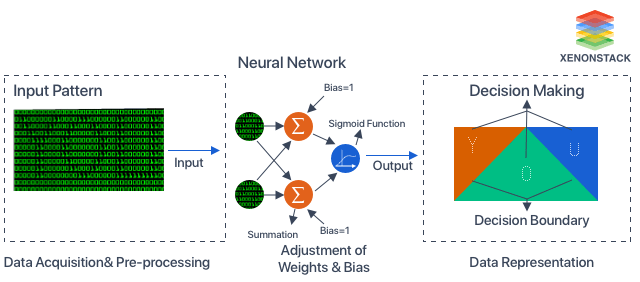 Pattern recognition is the study of how machines can observe the environment, learn to distinguish patterns of interest from their background, and make sound and reasonable decisions about the patterns’ categories. Some examples of the pattern are – fingerprint images, a handwritten word, a human face, or a speech signal. Given an input pattern, its recognition involves the following task –
Pattern recognition is the study of how machines can observe the environment, learn to distinguish patterns of interest from their background, and make sound and reasonable decisions about the patterns’ categories. Some examples of the pattern are – fingerprint images, a handwritten word, a human face, or a speech signal. Given an input pattern, its recognition involves the following task –
- Supervised classification – Given the input pattern is known as the member of a predefined class.
- Unsupervised classification – Assign pattern is to a hitherto unknown class.
So, the recognition problem here is essentially a classification or categorized task. The design of pattern recognition systems usually involves the following three aspects-
- Data acquisition and preprocessing
- Data representation
- Decision Making
Approaches For Pattern Recognition
- Template Matching
- Statistical
- Syntactic Matching
Following Neural Network architectures used for Pattern Recognition –
- Multilayer Perceptron
- Kohonen SOM (Self Organizing Map)
- Radial Basis Function Network (RBF)
A division of unsupervised learning which makes it more handful because it can also handle unsupervised learning which is itself a big plus.
Click to explore about our, Generative Adversarial Networks Applications
Neuro-Fuzzy Model and its applications
What is Fuzzy logic?
is the study of how machines can observe the environment, learn to distinguish patterns of interest from their background, and make sound and reasonable decisions about the patterns’ categories. Some examples of the pattern are – fingerprint images, a handwritten word, a human face, or a speech signal. Given an input pattern, its recognition involves the following task -So, the recognition problem here is essentially a classification or categorized task. The design of pattern recognition systems usually involves the following three aspects-Following Neural Network architectures used for Pattern Recognition –
Fuzzy logic refers to the logic developed to express the degree of truthiness by assigning values between 0 and 1, unlike traditional boolean logic representing 0 and 1.
What is Fuzzy logic role in Neural networks?
Fuzzy logic and it have one thing in common. They can be used to solve pattern recognition problems and others that do not involve any mathematical model.
What are the applications of Neuro-Fuzzy Model?
Systems combining both fuzzy logic and neural networks are neuro-fuzzy systems. These systems (Hybrid) can combine the advantages of both it and fuzzy logic to perform in a better way. Fuzzy logic and it have been integrated to use in the following applications –
- Automotive engineering
- Applicant screening of jobs
- Control of crane
- Monitoring of glaucoma
In a hybrid (neuro-fuzzy) model, Neural Networks Learning Algorithms are fused with the fuzzy reasoning of fuzzy logic. It determines the values of parameters, while if-then rules are controlled by fuzzy logic.
Neural Network for Machine Learning
- Multilayer Perceptron (supervised classification)
- Back Propagation Network (supervised classification)
- Hopfield Network (for pattern association)
- Deep Neural Networks (unsupervised clustering)
Neural Networks for data-intensive applications
It have been successfully applied to the broad spectrum of data-intensive applications, such as:
Application
Architecture / Algorithm
Activation Function
Process modeling and control
Radial Basis Network
Radial Basis
Machine Diagnostics
Multilayer Perceptron
Tan- Sigmoid Function
Portfolio Management
Classification Supervised Algorithm
Tan- Sigmoid Function
Target Recognition
Modular Neural Network
Tan- Sigmoid Function
Medical Diagnosis
Multilayer Perceptron
Tan- Sigmoid Function
Credit Rating
Logistic Discriminant Analysis with ANN, Support Vector Machine
Logistic function
Targeted Marketing
Back Propagation Algorithm
Logistic function
Voice recognition
Multilayer Perceptron, Deep Neural Networks( Convolutional Neural Networks)
Logistic function
Financial Forecasting
Backpropagation Algorithm
Logistic function
Intelligent searching
Deep Neural Network
Logistic function
Fraud detection
Gradient – Descent Algorithm and Least Mean Square (LMS) algorithm.
Logistic function
Face Recognition using Artificial Neural Networks
In a hybrid (neuro-fuzzy) model, Neural Networks Learning Algorithms are fused with the fuzzy reasoning of fuzzy logic. It determines the values of parameters, while if-then rules are controlled by fuzzy logic.It have been successfully applied to the broad spectrum of data-intensive applications, such as:
Face recognition entails comparing an image with a database of saved faces to identify the person in that input picture. It is a mechanism that involves dividing images into two parts; one containing targets (faces) and one providing the background. The associated assignment of face detection has direct relevance to the fact that images need to analyze and faces identified earlier than they can be recognized.
Face Recognition uses computer algorithms to find specific details about a person’s face.
Click to explore about our, Face Recognition with Deep Learning
What is learning rule in neural network?
The learning rule is a type of mathematical logic. It encourages to gain from the present conditions and upgrade its efficiency and performance. The learning procedure of the brain modifies its neural structure. The expanding or diminishing quality of its synaptic associations rely upon their activity. Learning rules in the Neural network:
- Hebbian learning rule: It determines how to customize the weights of nodes of a system.
- Perceptron learning rule: Network starts its learning by assigning a random value to each load.
- Delta learning rule: Modification in a node’s sympatric weight is equal to the multiplication of error and the input.
- Correlation learning rule: It is similar to supervised learning.
How can XenonStack help you?
Fraud Detection & Prevention Services
XenonStack Fraud Detection Services offers real-time fraud analysis to increase profitability. Data Mining is beneficial to detect fraud quickly and search for spot patterns and detect fraudulent transactions. Tools for Data Mining like Machine Learning, Cluster Analysis are beneficial to generate Predictive Models to prevent fraud losses.
Data Modeling Services
XenonStack offers Data Modelling using Neural Networks, Machine Learning, and Deep Learning. Data Modelling services help Enterprises to create a conceptual model based on the analysis of data objects. Deploy your Data Models on leading Cloud Service Providers like Google Cloud, Microsoft Azure, AWS, or on the container environment – Kubernetes & Docker.

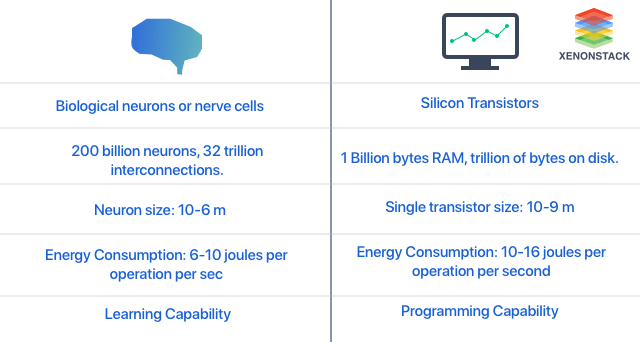
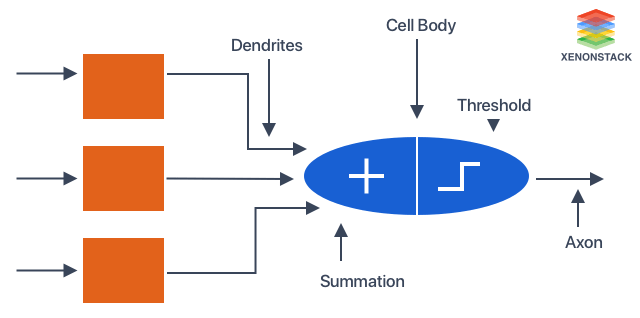
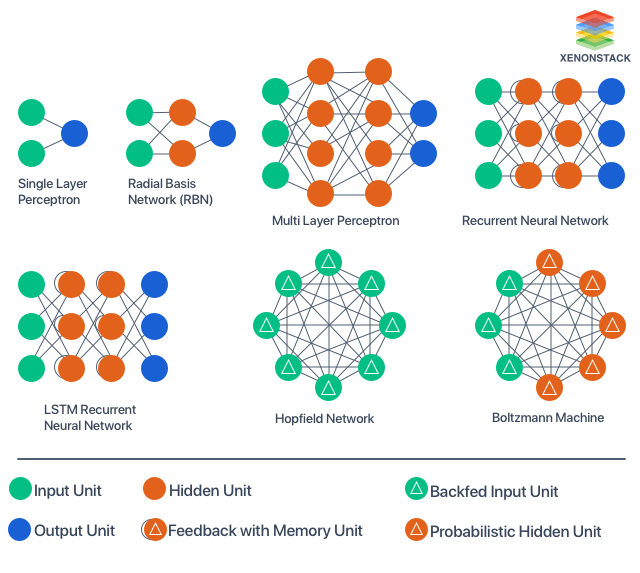














![Toni Kroos là ai? [ sự thật về tiểu sử đầy đủ Toni Kroos ]](https://evbn.org/wp-content/uploads/New-Project-6635-1671934592.jpg)


